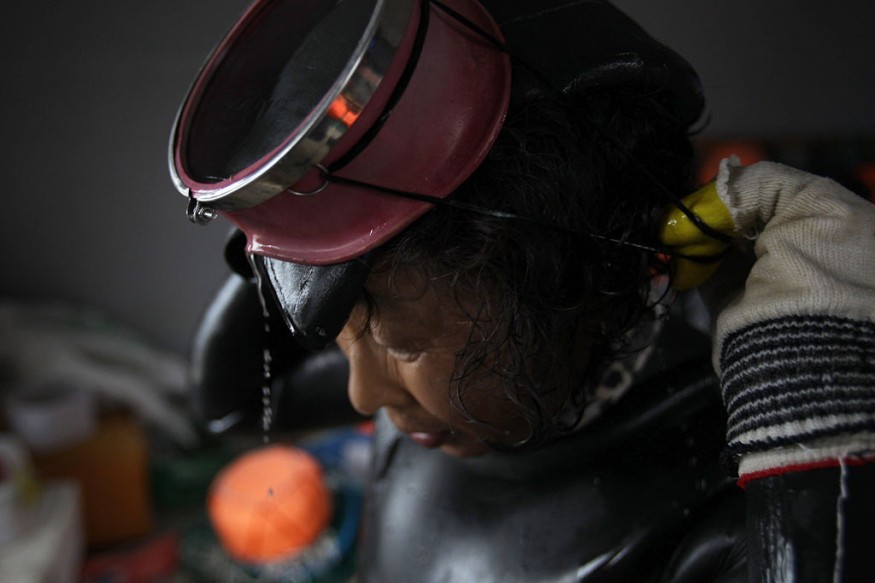The Bajau people, recognized as "sea nomads," have navigated the seas in beach houses for over 1,000 years, looking for food by diving with spears.
As a consequence, tremendous capacity to plunge to great depths has emerged throughout this Southeast Asian community.
Bajau Laut, known for their excellent breath-holding capacity, can dive up to 70m with little more than a range of weights and typical wooden goggles.
Scientists also found proof for wider spleens in the Bajau, an adaptation that enables them to swim for longer. The spleens are part of an effort to explain how "sea nomads" perform amazing diving feats.
This is the first time that human beings have shown evolution because of swimming.
"There's not a lot of information out there about human spleens in terms of physiology and genetics," said Dr. Melissa Ilardo, who undertook the study while she was a doctoral candidate at the University of Copenhagen.
"But we know that deep-diving seals, like the Weddell seal, have disproportionately large spleens. I thought that if selection acted on the seals to give them larger spleens, it could potentially do the same in humans."

Spleen Connection to Human Dive Response
Dr. Ilardo visited a Bajau population residing in the village of Jaya Bakti near the Indonesian island of Sulawesi.
The settlers of the community set out on long, frequent sailboat journeys, looking for fish. One of the people Dr. Ilardo encountered told her that he once spent 13 minutes underwater while hunting.
The community was keen to learn their genetic origins. Dr. Ilardo used a handheld ultrasound system to determine the scale of the spleens of 59 Bajaus.
Then in 34 individuals from a nearby village populated by non-Bajau citizens, she assessed spleen size so she could create a contrast.
Dr. Ilardo noticed that Bajau citizens had spleens around 50 percent greater than their neighbors when she brought her data back to Denmark to study.
Spleens are connected to human dive response. The pulse rate slows when the body is immersed in cold water, blood vessels shrink in the extremities, and the spleen contracts.
This contraction injects into circulation a spurt of extra oxygen-rich blood cells, helping the organism to live underwater for longer.
The swollen spleens of the Bajau could supply them with about 10 percent more blood cells than those with a normal-sized spleen, Dr. Ilardo and her collaborators calculated.
Dr. Ilardo took saliva samples from the subjects of the research, as well as calculating spleen size so that she could examine the genetic explanation for the variations she was observing.
She found many genes that were detected in the genomes of Bajau participants much more regularly, including one, PDE10A, involved in the development of thyroid hormone, which is correlated with spleen size in turn.
Dr. Ilardo suggests that such free divers have an improvement that raises the levels of thyroid hormone and thereby increases the scale of their spleen.
"If you genetically alter mice to have an absence of the thyroid hormone T4, their spleen size is drastically reduced, but this effect is actually reversible with an injection of T4."
This is the first development ever recorded in humans for swimming. Previous experiments used to suggest that children of sea nomads had superior underwater eyesight, but these observations have since been disproved.
Experts uploaded their study in Cell.
Future Studies
For a variety of factors, Dr. Ilardo's superiors Professor Eske Willerslev and Professor Rasmus Nielsen agree that her observations are important, after initially advising Dr. Ilardo against pursuing the work because of the possibility that she will not find any significant results.
Dr. Nielsen said evolution has produced tests that teach how humans respond and genetically adjust to a whole different range of physiological circumstances so that we can discover and understand even more about the relationship between genetics and physiology.
Understanding the biology underpinning the ability of the Bajau may also have medical research implications, particularly for those seeking to manage the disorder of acute hypoxia as oxygen is quickly drained by body tissue.
Cynthia Beall, an anthropologist at Case Western Reserve University in Cleveland, who also did not participate in the work, told The Scientist evaluations like this serve to provide observational proof of the natural evolution trajectory of our organisms and the time frames of these cycles.
Check This Out : Here's How Humans Are Still Evolving
Check out more news and information on Human Evolution on Science Times.
© 2025 ScienceTimes.com All rights reserved. Do not reproduce without permission. The window to the world of Science Times.









